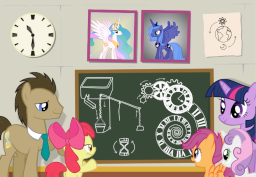
Chapter 6: A Brief History of Equestrian Time
Tock... Tock... Tock... Tock... Tock... Tock... Tock... Tock... Tock... Tock... Tock... Tock...
The Cutie Mark Crusaders stood in front of the swinging pendulum, turning first left, then right, to track its motion with their eyes. Doctor Hooves, Twilight and the three fillies had moved into the Eastern Hall of the abbey, where the clock continued to mark time, as it had thirteen hundred years ago. The steady pattern had again hypnotized the foals into silence.
“So this was the pendulum clock that marked time from that day on?” asked Twilight.
“Yes, indeed,” replied Hooves. It became known as The Second, being the second attempt to build a universal time standard, as it were, and thus set a new unit of time equal to one sixtieth of a minute. And this clock was used to mark time for many centuries. There were some modifications made. After fifty years it was found that it had the opposite problem to the minute—it ran just a little slower in summer and a little faster in winter, as the pendulum would expand with heat, increasing its length. Fortunately this was realised before the longer-than-scheduled summer days had much effect on the Equestrian climate. They made a new pendulum with two different types of metal, which expand at different rates, such that the effects cancel out and keep it the right length. Very ingenious.
“Over the years the scientists of the Order developed other timepieces. They soon found ways of making a weight attached to a spring oscillate back and forth with the same regularity. This worked as well as a pendulum, and had the advantage of being much easier to transport. So the watchmakers of the tenth century constructed a series of portable timepieces, each better than the previous one. The pinnacle of this achievement was the Canterlot Chronometer, so called because it was taken to Canterlot to keep accurate time within the city itself, and brought back to the abbey every three weeks to adjust it to match The Second. With the invention of chronometers Celestia and Luna no longer had to fly to the abbey twice a day, as they had their own portable timepieces.”
“Told you she had a fancy pony princess watch,” said Scootaloo.
“And the Princesses went back to live in the Castle of the Pony Sisters?” asked Twilight.
“Yes,” continued Hooves, “where they lived happily together, and fought many a prank war, for another century. But unfortunately, as we know, dark times would come again, and when they did they were darker than ever before. For as the Abbess had predicted following the water clock's demise, the princesses no longer viewed the Order with quite the same veneration as they had in those early days. Time was something that anypony could measure, if he or she had a good enough clock, and was no longer dictated by an elite group. So when Luna was overcome by jealousy of her sister, she no longer saw the need to let the Order dictate when she should lower the moon. If the Order had got it wrong before, who was to say that they were right now? Why should she let Celestia, the Order, or anypony else dictate the length of the night? Why could the night not last forever? Tragically once this thought had settled in her mind, it grew like a tumour, until the spirit of Nightmare Moon had taken control of her.”
“And the rest is history,” said Twilight.
“Yes, but a history which also decided the fate of the abbey, for in the violent struggle between Nightmare Moon and Celestia which followed on that fateful night, many a blast of magic was thrown by each pony into the sky and onto the ground. The fight began in their castle in the Everfree forest, but the two alicorns flew far and wide in the course of the battle. Canterlot Mountain itself was hit, triggering a landslide. Falling rock rained down onto the abbey roof, and the courtyard plaza was shattered and covered by falling masonry. The members of the Order fled into tunnels into the mountain. But when they returned, once Celestia had banished Luna and lifted the sun, they found the abbey buried under piles of rock. They were forced to abandon their home, and moved to Canterlot. They took what books and other belongings they could, but it was a hasty removal. The mountain had been thoroughly cracked and many paths were blocked. Pegasi tried to assist from the air, but it was difficult to alight onto the sharp fallen rocks, which would just tumble down once they set a hoof on the rubble. Eventually when everypony was safe in Canterlot, the Order re-established itself within the city. The Canterlot Chronometer became the new standard timepiece which counted the days and nights for the next few centuries. The Order built a splendid new building, just outside the castle walls, which would one day become Princess Celestia's School for Gifted Unicorns.”
“But they came back to restore the abbey one day?” said Twilight.
“All in good time,” continued the Doctor. “The Order resided in the city for three hundred and twenty-eight years. During this time Celestia took charge of both the sun and moon and raised and lowered them at the times measured by the chronometer. Those were austere times, and the number of ponies in the Order fell to just twenty-four at one point. But they took great pride in continuing the tradition, maintaining full records, and keeping the chronometer wound, oiled and adjusted. They kept this up for over three centuries. Until one fateful day...”
“What happened?” asked Apple Bloom.
“Celestia was having a difficult morning. Attempting to make up lost time and keep to her schedule, she was trying to raise the sun, levitating the chronometer in front of her to check the time, while at the same moment, reading a report from the Royal Guard and also eating her breakfast. This multitasking effort proved too much, as at that point her pet phoenix, standing on a perch on the opposite side of the table suddenly burst into flames. This of course did no harm at all to the phoenix, being all part of its natural life cycle, but Celestia's attention was momentarily distracted, and she let the chronometer drop into a large pot of strawberry jam.”
“Oh no!” said Twilight.
“It was an embarrassing moment for Celestia, but a much darker day for the Order. They cleaned up the mechanics as best they could, but being immersed in jam does tend to damage even the best watches. The chronometer never ran properly again. Of course they had other timepieces, and in a practical sense, it was not a serious problem, they just replaced Chronometer One with Chronometer Two. But they had counted every second since the first pendulum had swung. And now they thought they had lost that connection, and the clock they had brought from the old abbey had been lost. Everypony felt as wretched as they had broken a priceless heirloom.”
“So what happened then?”
“They wanted to remake the chronometer. But none of the Order at the time had the skill to accomplish the task, so they set out to relearn it. They read all the ancient books they had salvaged from the abbey, and made a few new chronometers, but none of these were as good as the old No. 1. Then the Fellowship of the day decided to launch an expedition to return to the old abbey and see if they could find some more books, or other information to help them. This was a major undertaking. It took several months for them to rebuild the old paths and bridges and excavate the rubble filled tunnels. Meanwhile the pegasi started to clear the fallen rocks by air, until they could safely land on the old plaza. Eventually in summer 1328, they finally removed the rocks blocking the doorway to the eastern hall.”
“And did they find the books they needed?” asked Twilight.
“Yes, and they also found something else.”
“What? What did they find?” asked Sweetie Belle, Apple Bloom and Scootaloo in unison.
“Strombol the Dragon. Who everypony had forgotten about. It had been assumed that he had flown off into the Foal Mountains during the chaos following Luna's exile. But they were wrong. He had stood by his place in the abbey, guarding the treasure. And when he found the rest of the Order had fled, he took charge of maintaining the Second, following his duty as a Fellow of the Order, lifting the weights each day, oiling the gears and ensuring everything ran smoothly. He also noted the times of sunrise and sunset each day, and kept full records. For three hundred and twenty-eight years he kept his place in the abbey. He did not know the fate of the rest of the Order. When they asked why he had not flown down to Canterlot, he replied that he did not like to leave the Second unattended. He always knew they would return one day.
“It was a joyous occasion for all. To return home to the abbey and find that they had not lost track of time after all. Strombol was hailed as a hero of the Order. They soon renovated the old buildings, and the abbey returned to the life it had known before they left. Strombol lived for another hundred and seventy years before he died peacefully at the age of eight hundred and seventy-four. There is a monument to him on the south slope of the mountain. The most long-lived, loyal and devoted Fellow ever to serve the Order.”
“I must tell Spike about him,” said Twilight.
“Since then the Order has continued to keep time. As before the exile, Celestia kept the Chronometer in Canterlot and came to synchronise it to the Second once a week. The Second kept time for another five hundred and sixty years. However it was eventually replaced when new timepiece technology was developed. In 1877, a former rock farmer, Piezo Electric, built a clock based on a quartz crystal, which, when an electric potential was applied, resonated at a very regular frequency. Even better than the best mechanical chronometers.
“Then in 1956, the descendants of the Practical Scholar Spin Precession, who had founded a satellite abbey to the west, finally achieved the dream of producing a cloud of cold atoms. By shining a laser system in such a cloud, they could see the atoms precessing, just as predicted, like spinning tops, and thus they made Equestria's first atomic clock. Such an instrument was installed in the abbey here, and is the most accurate timepiece ever made, which we use to this day to keep Equestria running to time. The second is now defined as nine billion one hundred and ninety-two million six hundred and thirty-one thousand seven hundred and seventy oscillations of a caesium atom. Our clocks can keep time so accurately that they gain or lose less than a second over a hundred million years.”
“Enough of the science stuff,” said Scootaloo. “Tell us what happened to Rap and the other novices.”
“That is another story. Once they had grown older, they were appointed Fellows of the Order, and lived their lives in the abbey for many years, maintaining the Second, eating many big dinners, and doing their best to discipline the novices which came after them. Patina and Ginger Root were both appointed Abbess for a period. It is likely that Rap would have also taken the role, except she got distracted by a passion for mountain climbing. Her wings never did lift her far off the ground, as does happen to to some pegasus ponies, but she was determined to scale as many peaks as she could in the Unicorn and Foal ranges. She spent most summers off on peak-bagging expeditions, but always returned to the abbey to see her friends each autumn.”
“She was really cool,” said Scootaloo. “It was great how she got her cutie mark in the end.”
“She would have been a crusader,” said Apple Bloom. “Except they didn't have crusaders in the olden days.”
The three fillies ran off around the museum hall which housed all the historic clocks used by the Order during the previous six centuries. The huge pendulum of the Second, the beautiful brass and gold mechanics of the Canterlot Chronometer Nos. 1,2,3 and 4. (No. 1 had been painstakingly cleaned of the jam residue and restored as a museum piece). The digital displays of the first quartz and atomic clocks were rather less visually impressive. Twilight and the Doctor continued chatting, until eventually they all grew tired of the hall and they walked together out onto the courtyard. By now it was early evening and the Western Hall cast a long shadow across the flagstones of the plaza, cutting the meridian line, through which the water flowed steadily.
Once outside, they were surprised by the sight of a group of stallions of the Royal Guard standing to attention. The reason for their presence was revealed once they turned to the side.
“Princess Celestia! Princess Luna!”
Twilight smiled at the unexpected arrival of the two sisters. The Doctor bowed his head politely. The Cutie Mark Crusaders bounced up and down too excited to remember the formal etiquette for how to greet the princesses of the sun and moon.
“Good evening Twilight,” said Celestia.
“What brings you here?”
“It is approaching the time of day when it is my duty to lower the sun, and allow Luna to lift the moon into view. While we could, of course, do this from Canterlot, and still get the time right thanks to the clock display the Order kindly fitted in my bedroom, connected by optical fibre directly to the Atomic Timepiece No. 4 here in the abbey. But it is nice, sometimes to fly up here and see the old buildings and old friends. So when we heard that you were visiting this afternoon, Luna and I decided it was time.”
“The Doctor's just been telling us a cool story,” said Scootaloo. “About you and Luna and the Abbess and Rap and the ponies who lived here in the old days.”
“And don't forget Strombol the Dragon,” added Apple Bloom.
“We remember them all well,” said Luna. “We were good friends.”
“Will you join us for dinner?” asked Twilight.
“We'd love to,” replied Celestia. “But first, we must perform our duty.” She glanced up at the face of the clock on the tower built into the cliff. “It is nearly time.”
“Of course.”
“And since we are here,” continued Celestia. “Why don't we act out the traditional rite, as it was done in that bygone era. “It will be the first time I have performed it together with Luna in over a thousand years.”
Everypony agreed with this proposal.
“We need somepony to preside over the ceremony,” continued Celestia. “Could you do it Twilight?”
“I could,” said Twilight. “But as I am not a member of the Order. I think I should defer to the Doctor.”
Dr Hooves nodded his head to agree. Then the ponies moved into their position. Celestia and Luna facing one another on either side of the meridian. The Doctor stood on the podium straddling the zero longitude water channel, facing the clock. Twilight and the young girls stood to one side to watch, together with the other tourists, guard ponies, and the members of the Order who had come out to watch the proceedings.
The clock showed 7:19, and sunset was scheduled for 7:21. For two minutes the crowd waited in silent anticipation. Then as the minute hand of the clock moved into position, the Doctor sang out the opening line of the liturgy with perfect pitch.
“By the authority vested in me as a member of the Order of the Time Turners I hereby ask Her Royal Highness Princess Celestia to lower the sun—”
Celestia spread her wings and stood on her hind hooves, her horn aglow. As she focussed her magic, the audience stared to the west watching the sun fall beneath the horizon. The sky fell dark and the twinkling stars appeared above the mountains. The crowd of ponies now turned their heads to the east to face Princess Luna as the Doctor began the next verse.
“Now that the day has finished and the night is begun I hereby ask Her Royal Highness Princess Luna to lift the moon—”
With her eyes closed, Luna gently flapped her wings, rising slightly above the ground as a white aura appeared around her horn, silently coaxing the moon above the horizon. The ponies watched the gleaming white disk rise into the sky, shining moonbeams onto the plaza, and casting shadows across the courtyard.
“We thank you the Royal Pony Sisters in the name of the Unicorns and the Pegasi and the Earth Ponies. Amen.”
The Doctor finished the ceremony, and walked towards the centre of the plaza. Luna and Celestia did the same at a steady pace. With a series of whoops and cheers the Cutie Mark Crusaders rushed forwards to join them, followed by Twilight. The other ponies present all stomped their hooves on the flagstones to applaud the show.
The day complete, and all ceremonies done. The princesses, fillies and the Doctor all went into the Western Hall where dinner was waiting to be served. As guests of honour they were invited to sit at the high table. Scootaloo and Sweetie Belle both insisted on sitting next to Princess Luna. Celestia, Apple Bloom, Twilight and the Doctor all settled on cushions on the opposite side of the table. Once the dishes were brought in, the fillies and the two alicorn sisters forgot about their companions and enthusiastically attacked their food. Twilight watched them with affection before catching the Doctor's eye.
“Thank you so much for showing them around the abbey and for telling such a great story. You really are an outstanding storyteller. You make the whole place come alive with the way you talked about the ponies who lived here so many years ago. It's as if you've actually met them.”
The Doctor smiled.

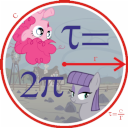

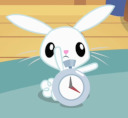


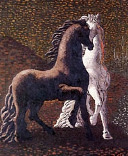
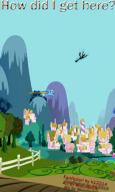






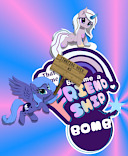

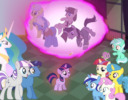






Wow! It's complete! Congratulations, Pineta!
Farewell Strombol, old and faithful freind.
Guys?
The 1st atomic clocks would gain or loose a second in 10^6 years. Current atomic clocks gain or loose a second in 10^8. Optical and Quantum Clocks, under development, might stretch this to gain or loose a second in 10^11 years.
A very fun pony-flavored history of horology. Thank you for it.
I thought this was lovely. Thank you.
A lovely and quaint little story! The only problem I can really say I had with it was the brief interludes - the shushing of whoever was trying to interject got a bit repetitive and a tad annoying at times, but I was otherwise happy with how the story turned out ^^
6611662 You're quite welcome.
I'm actually editing for a story now, the prequel to one of my favorites on the site. It's Lady Froey's Major and Minor. But I'm quite available these days, if you need a prereader or anything.
Hoo boy, This was a great story! I wish more people would read it.
Brilliant ending. This story reminds me of Harry Potter. Right down to the time travel. Brings me back to when I was a kid.
"built into"
"closed"
"sitting"
Probably meant "to this day," but this works, too.
I feel like directly would work better, but that might just be an American thing.
Glad to be done with the corrections, as I feel I may have worn out my welcome.
6620084
Really glad you liked it, and thanks for all your work picking up all the typos. Kinda embarrassing that there were so many in that last chapter. I don't know how I could read it so many times without spotting them.
This is a beautiful story an the nod to the Doctor is excellently woven into things. Rap is especially enjoyable, as is Strombol.
Bravo.
6620084
I shall read it...
(Moral: It's like a sort of monkey's paw. You have to be careful of the hubris in your wishes. *NEEERRRRRD!* )
6741008
i.imgur.com/l2OFbuH.png
6815825 You might try a small release valve for the water experiment. I believe those can be purchased for a few dollars.
I have an idea of how to do it... if I get time one of these eons I might actually build the little setup.
As for the rest, I still suspect aliens.
i1143.photobucket.com/albums/n635/HarryLeferts/professor-derpy-meme-generator-now-i-m-not-saying-ancient-humans-but-ancient-humans-67f9d2.jpg
6748396 Time Ponies... but beware the Master!
fc05.deviantart.net/fs70/i/2012/093/2/c/discorded_whooves_master_drums__by_peora-d4uwovu.png
Dom-dom-dom-dom...
That was a great story. As the story progressed the interludes helped it feel as though I was being told as story, not just reading one. Twilight breaking in toward the later half of the story really felt in character, and I could really see the CMC going to the order with her, Considering Twilight Time.
It's a shame this doesn't have more views, I'll send it along to my friends, as it's certainly made my day abit better.
6963254
Thanks. The interruptions were something of an afterthought. In the first draft I just had Twilight and the CMC giving an introduction and conclusion. My prereader suggested to bring them into the middle, and it then turned into a fun exercise of reading through the story and thinking what sort of comments Apple Bloom, Sweetie Belle, and Scootaloo would make. And the same for Twilight.
Geeze, it's really hard to compensate for, well, everything.
Dangit, Luna.
So Celestia literally jammed the chronometer? You just can't depend on princesses for anything these days.
Dragons, on the other hand, are apparently much more reliable.
Oh, absolutely.
Hey, cool, they did eventually get atomic clocks.
Heh.
Neat.
Fun story, and that was a wonderful little ending.
7045783
Thanks for all the comments. It's great to read how you respond to all the twists and turns in a story.
7065228 The oil is made of the G1-G3 ponies who died from a mass cancellation event millions of years ago.
7211744
you didn't read any of what I wrote did you?
over the course of natural history carbon levels have fluctuated between 0.028 - 0.45% [range of 0.422]
current global range is 0.036 - 0.041 [range of 0.005] depending on if the reading were taken in rural, forested, or urban locations
a range variation of 1.185% easily dismissed as scientific experimental error caused by urban emissions .
Urban locations skew the data set higher than the global average.
Water vapour, oxygen, and nitrogen which make up the most mass in the atmosphere
and the tilt of the global axis, have more of an impact on weather than the trace levels of carbon dioxide.
and I certainly wouldn't trust politicians, paid-off scientists, or rocket scientists,
to decide weather "truth" that is designed to support a carbon tax,
which is designed to damage the economy.
when the freely available data shows the complete opposite
than what they are trying to sell to the public sheep.
in fact 20 years ago they were trying to sell global cooling.
they change the koolaid every few decades.
feel free to drink it, but don't spread lies.
7479522
Ah yes. When my wife had I had our bans read, our local parish was a very High Church establishment. Actually a very enjoyable three weeks. Not only was it a nice change from the normal, but the church was almost literally across the road so I got a lie in to boot.
Enjoying your stories very much, by the way. Some very interesting ideas.
A beautifully Equestrian take on science as always.
Have you ever considered writing educational fantasy for kids - offline, I mean?
10958573 I have considered lots of crazy ideas for mixing fiction and science education. Unfortunately finding the time to pursue any of them at the moment is proving difficult.
I have considered lots of crazy ideas for mixing fiction and science education. Unfortunately finding the time to pursue any of them at the moment is proving difficult.
Thank you
Delightful all the way though, from the creation myths to the leap years to the hard science to the implications of the very last line. Loved this story and learned a lot. Thank you.
My favourite detail is the griping early on about how fast summer days seem to go and how slow the cold winter is ... Hmm!
11378928
Thanks. It's been a while since I thought about this one, but I remember when writing it, it took over my mind and for months I was thinking about clocks and time keeping all the time when I should have been focussing on other things.
This was delightful to read. I have a fondness for clocks, so seeing an entire story about the history of pony clocks was fantastic. Thanks for a good read.